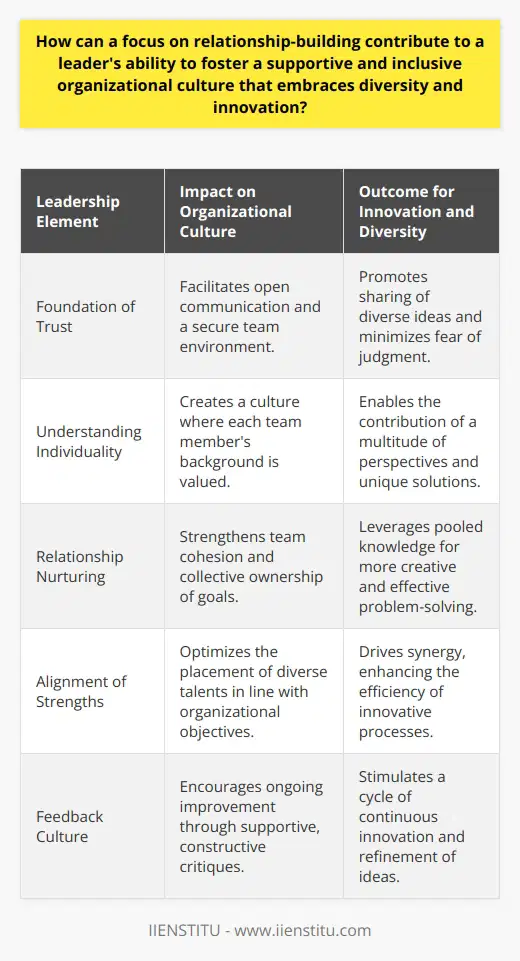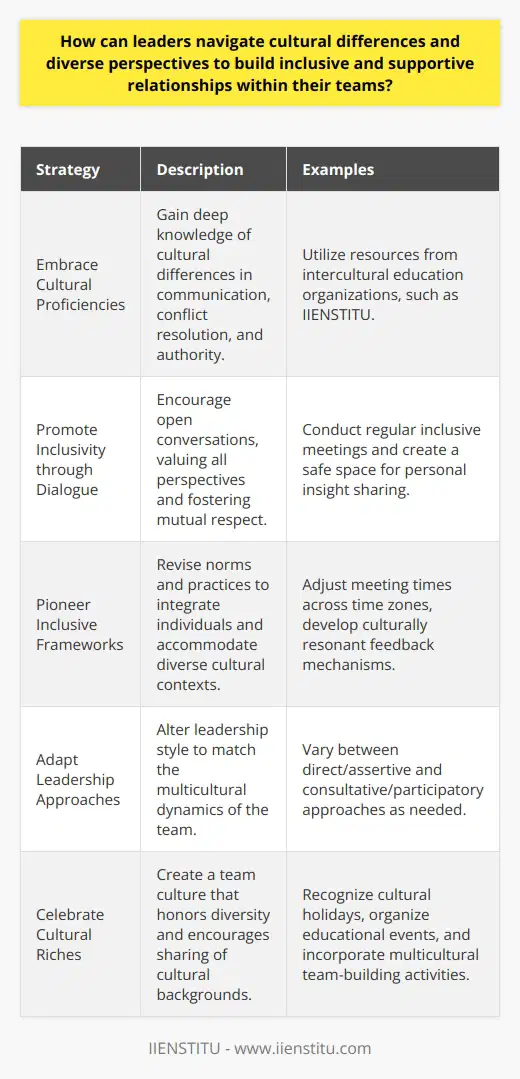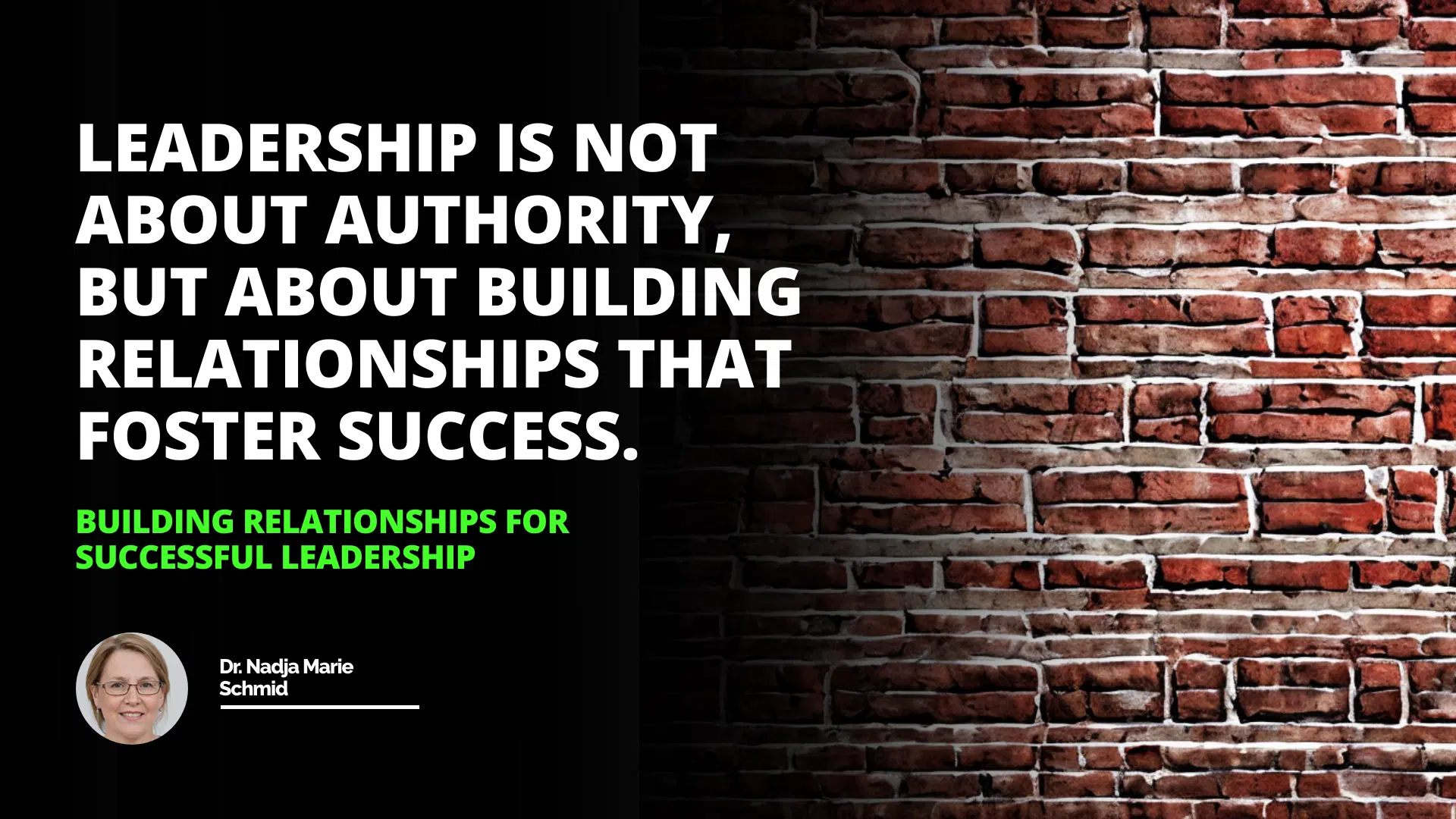
This article has discussed the importance of relationship-building with stakeholders, building influence and capital, and diagnosing the prevailing culture to ensure a successful transition for a new executive in a company. The new executive needs to foster relationships with a wide range of stakeholders, establish credibility and trust with stakeholders to build influence and capital, and identify any dysfunctional elements in the prevailing culture.
Introduction
Relationship Building with Stakeholders
Building Influence and Capital
Diagnosing the Prevailing Culture
Conclusion
Introduction: The transition of a new executive into a company can be challenging and stressful. As the executive takes on the new role, they must gain the trust and respect of stakeholders, build influence and capital, and diagnose the prevailing culture. This article will discuss the importance of relationship-building with stakeholders, making power and money, and analyzing the prevailing culture to ensure a successful transition.
Relationship Building with Stakeholders
New executives must foster relationships with many stakeholders to ensure a successful transition. Dialogue with stakeholders is necessary to shape priorities and move forward on critical objectives. Moreover, good relationships make it easier to accomplish these objectives. Our research and labs show that the most successful executives have invested in building relationships with their stakeholders.
Building Influence and Capital
New executives must invest in building capital to exercise influence and drive transformation agendas. Money can be made through relationships, collaboration, and communication. It is also essential to establish credibility and trust with stakeholders to build influence and wealth.
Diagnosing the Prevailing Culture
Incoming executives must consider diagnosing the prevailing culture. It is essential to understand the culture to identify dysfunctional elements. For example, there may be rivals for leadership positions, cliques, and divergent personalities. It is necessary to identify these elements to ensure a successful transition.
Related Course: Online Leadership Course
Conclusion: The transition of a new executive into a company can be challenging and stressful. As the executive takes on the new role, they must gain the trust and respect of stakeholders, build influence and capital, and diagnose the prevailing culture. This article has discussed the importance of relationship-building with stakeholders, making power and money, and analyzing the prevailing culture to ensure a successful transition.
Leadership is not about authority but about building relationships that foster success.
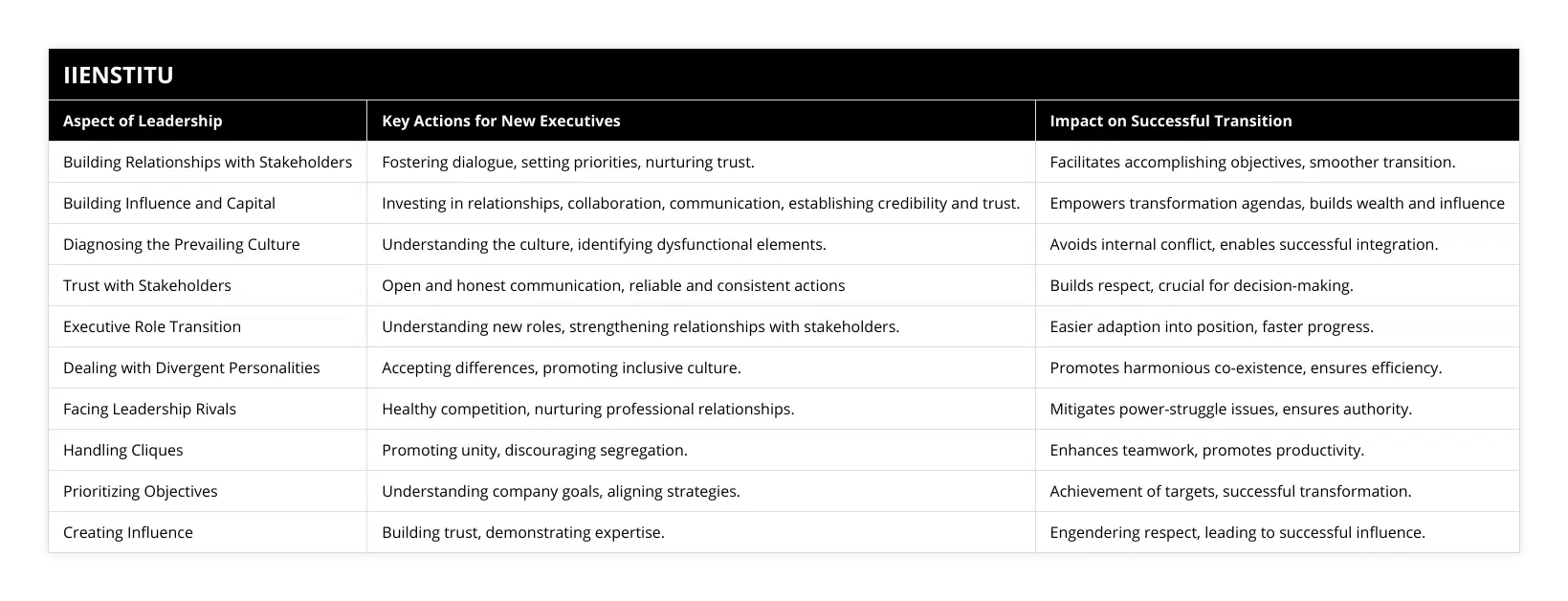
Frequently Asked Questions
What strategies can be used to build relationships with stakeholders for successful leadership?
Successful leadership involves more than just having the right skills and knowledge. It also involves building relationships with stakeholders, which is essential for any successful leader. Building relationships with stakeholders can be challenging but necessary for successful leadership. Here are some strategies for building relationships with stakeholders for successful leadership:
Establish Communication: Establishing communication with stakeholders is critical to successful leadership. Good communication is the foundation for building relationships with stakeholders. Therefore, leaders should establish regular communication with stakeholders through emails, phone calls, and meetings.
Listen to Stakeholders: Leaders should listen to stakeholders and take their opinions and feedback seriously. This will help build trust and mutual understanding between the leader and stakeholders. Leaders should also be open to feedback and suggestions from stakeholders.
Show Respect: Showing respect to stakeholders is essential for successful leadership. Leaders should always be respectful of others and demonstrate respect for their opinions and ideas. This will help build relationships with stakeholders and create a positive atmosphere.
Build Trust: Building trust is essential for successful leadership. Leaders should strive to build trust with stakeholders by being honest, reliable, and transparent. Leaders should also strive to be consistent in their actions and words.
Collaborate: Collaboration is critical for successful leadership. Leaders should strive to work with stakeholders to come up with solutions and ideas that benefit all parties. This will help create a strong relationship between the leader and stakeholders.
These strategies can help leaders build relationships with stakeholders, which is essential for successful leadership. Establishing communication, listening to stakeholders, showing respect, building trust, and collaborating are critical strategies for building relationships with stakeholders.

How can leaders build influence and capital through relationship building?
In today's business world, relationships are crucial for leaders who want to build influence and capital. Building relationships with employees, stakeholders, and the public can help leaders gain the trust and respect of their peers and be more successful in their roles. This article will discuss how leaders can build influence and capital through relationship building.
The first step in building relationships is to create an environment of trust and respect. Leaders can do this by being consistent in their communication and decisions, creating clear expectations, and providing honest feedback. Leaders should also build relationships with stakeholders, such as customers, suppliers, and investors. These stakeholders can provide valuable insights and resources to help leaders achieve their goals.
Leaders should also focus on developing emotional intelligence. Emotional intelligence is the ability to understand and manage emotions in oneself and others. Leaders with high emotional intelligence can build strong relationships with their team and stakeholders, leading to increased influence and capital.
Leaders should also utilize networking opportunities to expand and build relationships with key individuals and organizations. Networking allows leaders to gain insight into different perspectives and build relationships with people who can help them in their roles.
Finally, leaders should strive to build relationships with the public. By engaging with the public and understanding their needs and concerns, leaders can build trust and support, which can help them gain influence and capital.
In conclusion, building relationships is essential for leaders who want to make influence and capital. Leaders can increase their power and money by creating trust and respect, developing emotional intelligence, utilizing networking opportunities, and engaging with the public.
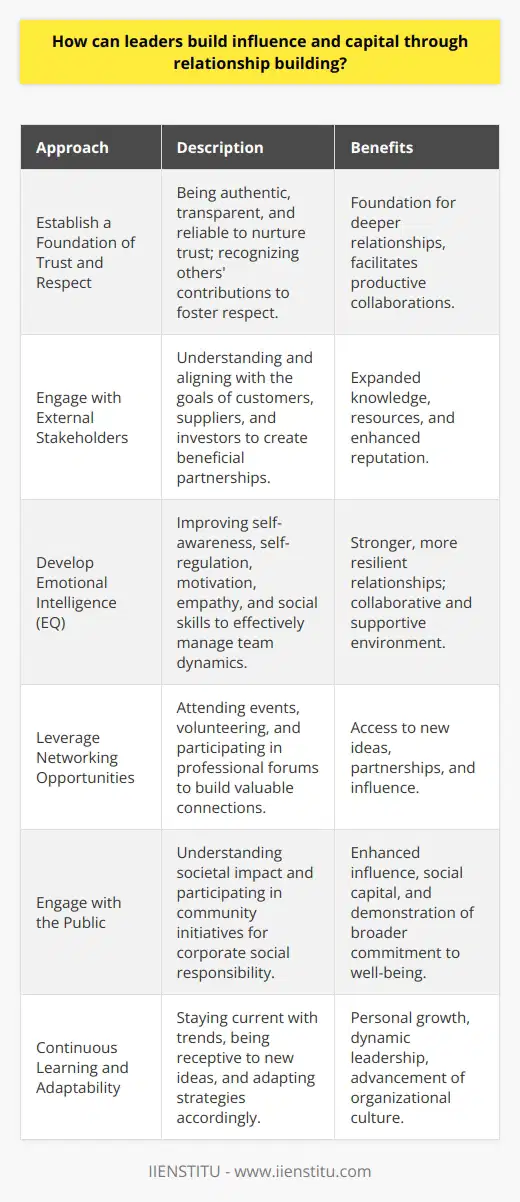
What techniques can be used to diagnose the prevailing culture in order to build successful relationships?
The ability to accurately diagnose the prevailing culture to build successful relationships is a crucial skill for any professional. Understanding the norms and values of a particular culture is essential for developing a productive working relationship with clients, colleagues, and partners. This article will outline several techniques that can be used to diagnose the prevailing culture to build successful relationships effectively.
The first technique is to observe the environment of the culture in question. This can include keeping the language, dress code, and any other cultural cues that are present. By following the environment, it is possible to gain a better understanding of the prevailing culture and the values that it embodies. Additionally, it is essential to pay attention to the people's behaviors in the culture, as they can provide clues as to the values and norms present in the culture.
The second technique is to engage in conversation with members of the culture. By having meaningful conversations, it is possible to gain insight into the values and beliefs of the culture. The discussions should be open-ended, allowing for meaningful dialogue and an exchange of ideas. Additionally, it is essential to ask questions pertinent to the culture, as this can provide further insight into the prevailing culture.
The third technique is to research the culture. Studying the history, customs, and traditions of the culture makes it possible to understand the culture and its values better. Additionally, it can be beneficial to read books and articles written by members of the culture, as these can provide further insight into the culture and its values.
Finally, it is essential to examine the behavior of the culture. By looking at the culture's behavior culture, it is possible to gain insight into its values. Additionally, it is essential to pay attention to the people's reactions within the culture, as they can provide further insight into the values and norms present.
By utilizing these techniques, it is possible to diagnose the prevailing culture to build successful relationships. By understanding the values, beliefs, and norms of the culture, it is possible to develop meaningful relationships and foster an environment of mutual respect and trust. Additionally, it is essential to remain open to new ideas and perspectives, as this can help to bridge cultural divides and build successful relationships.
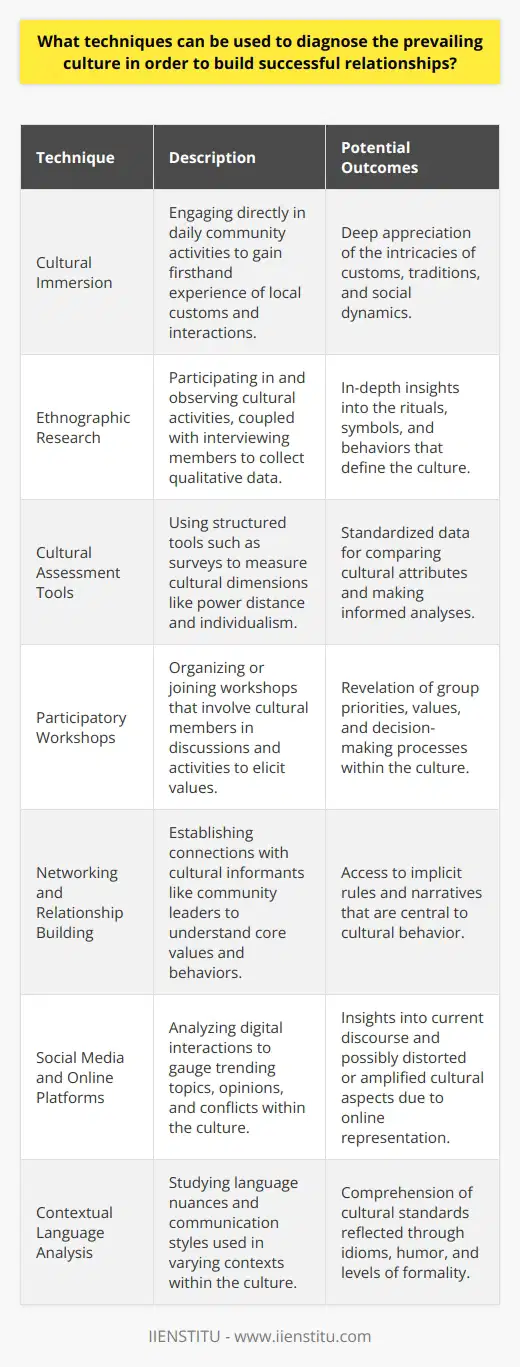
Why is building relationships important in leadership?
Significance of Relationships in Leadership
Building relationships holds paramount importance in leadership as it directly influences a leader's effectiveness in driving organizational success. The ability to establish and maintain strong relationships fosters an environment conducive to collaboration, trust, and open communication.
Enhancing Communication and Trust
Effective leaders recognize the value of forging strong relationships, paving the way for open channels of communication. Frequent and honest communication strengthens trust among team members, enabling them to share their ideas and concerns without fear of reprisal.
Promoting Collaboration and Synergy
When people trust their leader, they are more willing to collaborate and work towards shared goals. Interpersonal relationships foster camaraderie, which ultimately helps in amplifying a team's overall performance. Effective leaders create spaces for such interactions, which nurture a collaborative work atmosphere.
Boosting Employee Morale and Retention
Authentic and respectful relationships between leaders and their teams contribute to a positive work environment. Employees who feel valued and supported by their leader experience higher job satisfaction and commitment, leading to increased productivity and reduced turnover.
Influence and Persuasion
Showcasing the ability to build relationships strengthens a leader's influence and persuasion skills. Establishing rapport with diverse stakeholders facilitates better negotiation and conflict resolution, thereby enabling the achievement of organizational objectives.
Overall, the importance of building relationships in leadership cannot be overemphasized. Strong interpersonal skills contribute to the overall effectiveness and success of a leader, which has a lasting impact on the organization's growth and prosperity.
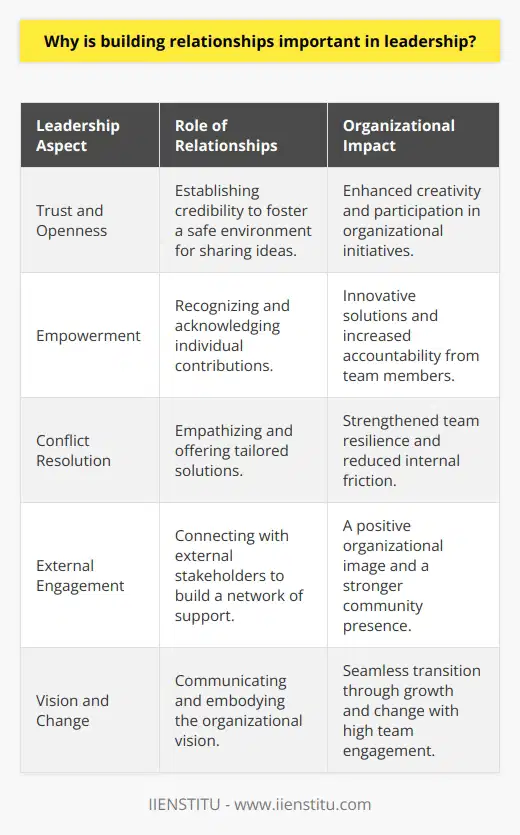
What are the 5 ways to build great work relationships?
Building Strong Work Relationships
**1. Communication**
Effective communication is essential in fostering successful work relationships. It involves actively listening, being open-minded, and engaging in discussions. Sharing ideas and opinions, both privately and in meetings, encourages a transparent and honest work environment, where team members feel valued and respected.
**2. Trust**
Trust comprises the foundation of any relationship, including professional ones. Building trust within the workplace occurs through honesty and reliability. Consistently fulfilling tasks and commitments demonstrates dependability, which strengthens the bond among colleagues. Furthermore, having faith in others' abilities to perform their job responsibilities fosters a sense of trust and collaboration.
**3. Support**
To establish strong work relationships, offering support and encouragement is crucial. This can be achieved by providing constructive feedback, praising others' contributions, or assisting team members with challenging tasks. Actively engaging in mentoring and coaching assists in personal and professional growth, ultimately benefiting the organization as a whole.
**4. Emotional Intelligence**
Possessing emotional intelligence contributes significantly to the development of solid work relationships. By understanding and managing one's emotions, individuals can navigate conflicts and work-related stress efficiently. Being empathetic and compassionate towards one's colleagues enables cohesive teamwork and conflict resolution, enhancing the overall workplace atmosphere.
**5. Socializing**
Lastly, forming connections both during and outside work hours can improve work relationships. Engaging in team-building activities, social events, or informal lunch meetings creates a sense of camaraderie and unity. Encouraging informal connections enhances the rapport among colleagues, fostering mutual respect and understanding.
In conclusion, nurturing robust work relationships depends upon effective communication, establishing trust, providing support, demonstrating emotional intelligence, and socializing outside the workplace. Implementing these strategies can lead to a harmonious and productive work environment where employees are more likely to experience satisfaction and success in their roles.
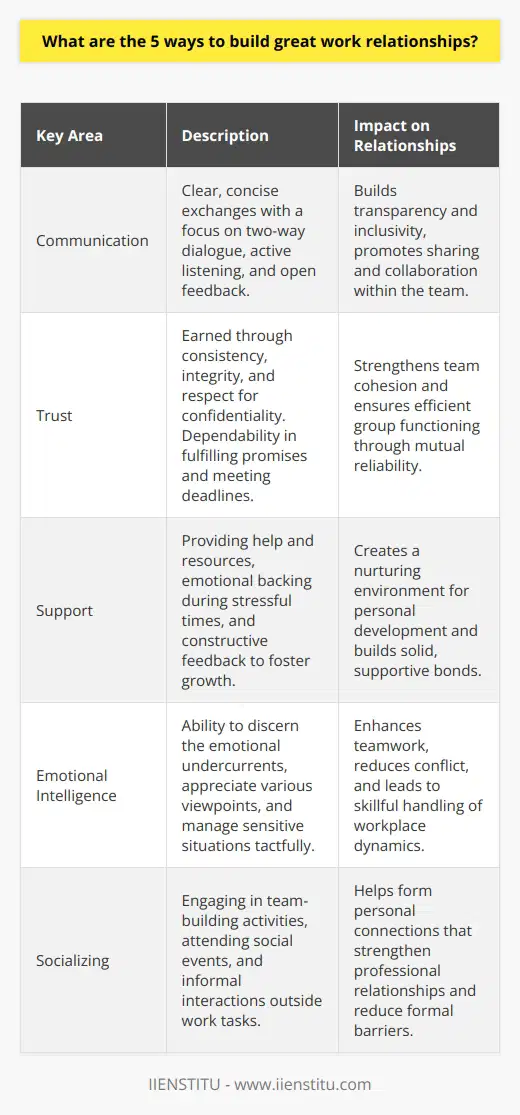
Why is it important for a leader to have meaningful relationships?
Building Trust within a Team
Having meaningful relationships is essential for leaders because it helps to build trust within their team. This trust promotes open communication, which in turn fosters an environment where team members feel comfortable sharing their ideas and concerns.
Effective Communication and Collaboration
Moreover, meaningful relationships enable leaders to understand their team members on a deeper level, allowing them to establish effective communication channels. They can also tailor their management approach based on individual strengths and weaknesses, encouraging collaboration and promoting a sense of ownership in the team's success.
Promoting Team Morale and Job Satisfaction
Additionally, leaders who have meaningful relationships with their team members contribute to higher team morale and job satisfaction. Employees who feel valued, understood, and appreciated are more likely to feel motivated and engaged in their work. This increased satisfaction, in turn, can lead to greater productivity and overall success for the organization.
Facilitating Conflict Resolution
Conflict is inevitable within a team, but having meaningful relationships can help leaders address and resolve issues more effectively. By understanding each team member's perspective and approach, a leader can better manage conflicts and find a resolution that benefits everyone involved.
Increasing Employee Retention
Finally, leaders who forge meaningful relationships with their team members can increase employee retention rates. A strong relationship with one's direct supervisor is a vital component of the overall job satisfaction, which is a key factor in retaining employees. High retention rates can significantly benefit the organization by reducing the costs associated with employee turnover.
In conclusion, it is important for leaders to establish and maintain meaningful relationships with their team members as this fosters trust, effective communication, and collaboration within the team. Furthermore, positive relationships contribute to higher team morale, job satisfaction, facilitation of conflict resolution, and increased employee retention. By developing meaningful relationships, leaders can significantly enhance the overall success of their team and organization.
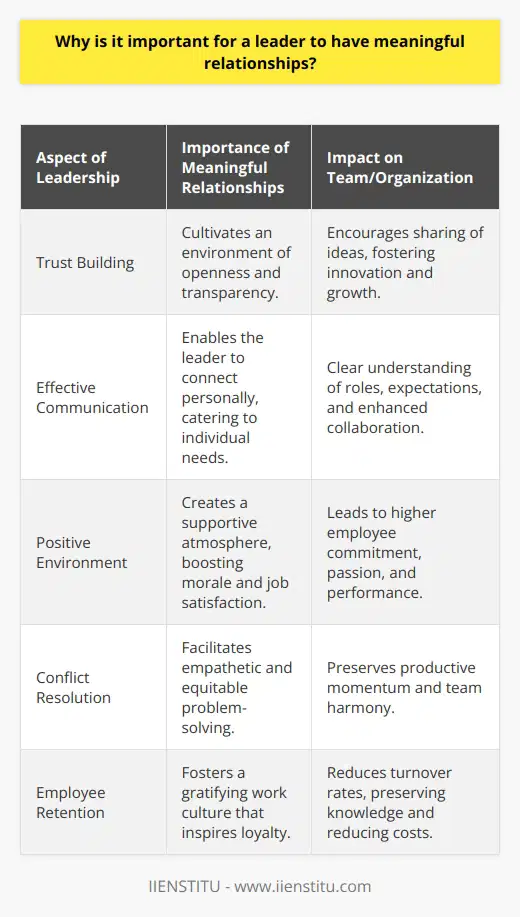
Why are building relationships crucial for a leader's success?
Importance of Building Relationships for Leaders
Strong interpersonal connections serve as the foundation for successful leadership. Developing relationships with subordinates, colleagues, and other stakeholders enables a leader to foster trust, communicate effectively, and, most importantly, support the overall purpose of the organization.
Value of Trust
One of the primary reasons why building relationships is crucial for a leader's success lies in the importance of trust. When leaders invest time and effort in forging connections with their team members, they create an environment where trust can flourish. Employees are more likely to follow a leader they trust, leading to increased engagement, higher productivity, and a more harmonious workplace.
Effective Communication
Another key component of successful leadership is effective communication. By cultivating strong relationships, leaders can establish open lines of communication with their team members, enabling them to share important information, align goals and expectations, and provide feedback. This open communication is essential for ensuring everyone is working towards a common objective and makes it easier for leaders to identify and address potential issues before they escalate.
Promoting Collaboration
Strong relationships within a team also promote collaboration, which is essential for driving innovative solutions and achieving organizational objectives. When team members feel connected to their leader and one another, they are more likely to work together to find creative approaches to problems and share ideas that may result in positive outcomes for the organization. In turn, this sense of collaboration can contribute to a competitive advantage in the marketplace.
Understanding Team Dynamics
Building relationships also enables a leader to better understand the dynamics within their team, facilitating more effective talent management. By engaging with employees on a personal level, leaders can gain insight into individual strengths, weaknesses, and motivations. This knowledge allows them to leverage each team member's unique abilities and address any areas of potential conflict or tension.
In conclusion, building relationships is essential for a leader's success because it cultivates trust, fosters effective communication, promotes collaboration, and enables a deeper understanding of team dynamics. By investing in strong interpersonal connections, leaders can position themselves and their organizations for success in today's increasingly complex and competitive business landscape.
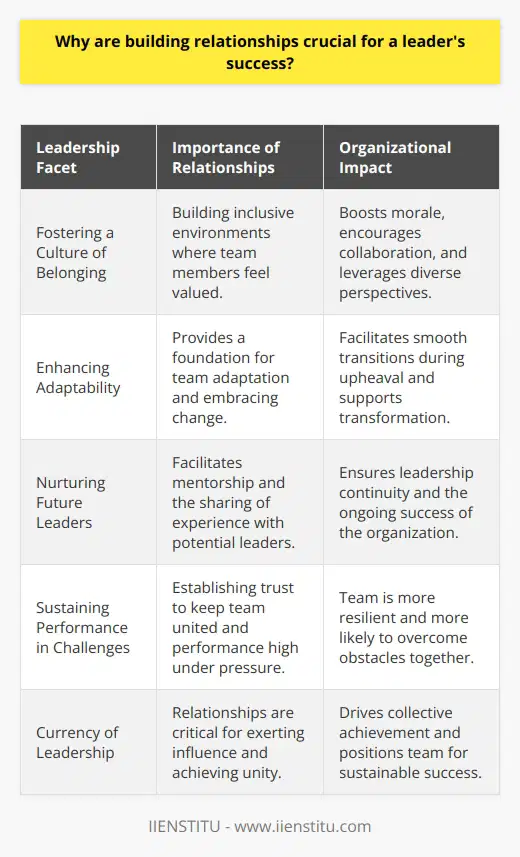
How do strong interpersonal connections contribute to effective decision-making in leadership?
Significance of Interpersonal Connections
Strong interpersonal connections play an essential role in fostering effective decision-making in leadership. Leaders who have well-developed relationships with their colleagues and subordinates are better equipped to gather valuable information and diverse perspective. Consequently, this empowers them to make more informed and comprehensive decisions.
Positive work environments
In organizations where members share a sense of camaraderie and trust, individuals tend to be more forthcoming with their thoughts and ideas. This transparency cultivates an environment where leaders can proactively tackle complex issues, as they rely on honest feedback and constructive criticism. Through robust interpersonal connections, leaders can draw on the collective wisdom of the team, ultimately enhancing the quality of their decisions.
Active listening for informed choices
Leaders who actively listen and sincerely engage with their colleagues demonstrate their receptiveness to different viewpoints. By instilling a culture of open communication and dialogue, leaders can make well-rounded decisions that effectively address critical challenges. Active listening also allows leaders to identify any potential gaps in their understanding or approach, refining the decision-making process further.
Team collaboration and joint decision-making
The presence of strong interpersonal connections within a team promotes active collaboration, as members feel more comfortable expressing their opinions, raising concerns and offering suggestions. This joint decision-making approach not only fosters higher levels of employee engagement and satisfaction but also results in more innovative and sound decisions. A cohesive team with strong interpersonal connections yields a resilient support system for leaders, enabling them to overcome obstacles and continuously improve.
In conclusion, strong interpersonal connections are integral for effective decision-making in leadership. Developing relationships based on trust, active listening, and collaboration is crucial for leaders to harness the collective knowledge and expertise of their teams. Ultimately, fostering these connections leads to more informed, strategic, and successful decision-making processes.
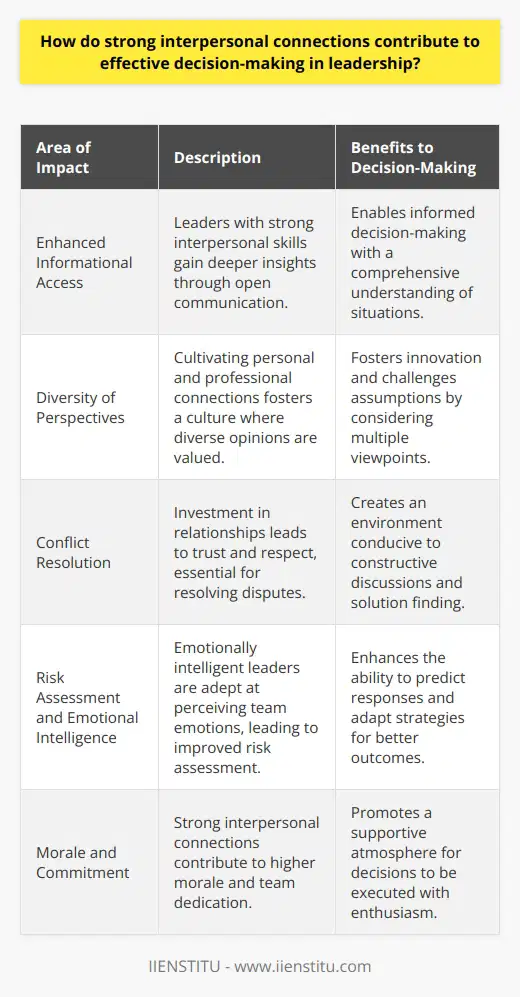
In what ways does relationship-building impact a leader's ability to manage change and foster innovation?
Understanding Individual Needs
Relationship-building significantly impacts a leader's ability to manage change and foster innovation by allowing them to understand their followers' individual needs. By forming deep connections with their team members, leaders can gain insight into their skills, strengths, weaknesses, and personal aspirations. This, in turn, helps them to identify opportunities for growth and improvement, as well as to develop innovative solutions that cater to the unique needs of their team and organization.
Establishing Trust
Moreover, strong relationships based on mutual trust enable leaders to manage change more effectively. When team members trust their leader, they feel more confident in their ability to tackle new challenges and less threatened by the uncertainties that may accompany change. Consequently, they become more receptive to novel ideas, and more willing to collaborate on innovative projects. Trust also facilitates honest communication, which is critical for successful change management and the development of groundbreaking solutions.
Empowering Team Members
Additionally, relationship-building empowers team members, fostering a culture of innovation within the organization. When leaders take the time to invest in their relationships with followers, they demonstrate genuine care and respect for their contributions. This can boost morale, motivate employees to strive for excellence, and encourage them to contribute their own unique ideas for driving growth and change. Leaders who empower their teams in this way create an environment where creativity and innovation can thrive.
Leveraging Network Connections
Lastly, leaders who excel at relationship-building can extend their influence beyond their immediate team, leveraging their network connections to facilitate change and innovation at an organizational level. By engaging in collaboration with a diverse range of stakeholders, such as peers, department heads, and external partners, leaders can gather valuable insights, resources, and support to enable more effective change management and the pursuit of innovative projects. This cross-pollination of ideas and perspectives often results in creative breakthroughs and organizational transformation.
In conclusion, relationship-building greatly enhances a leader's ability to manage change and foster innovation by gaining a deeper understanding of individual needs, establishing trust, empowering team members, and leveraging network connections. By honing these skills, leaders can inspire their followers, improve collaboration, and ensure the ongoing success and growth of their organizations.
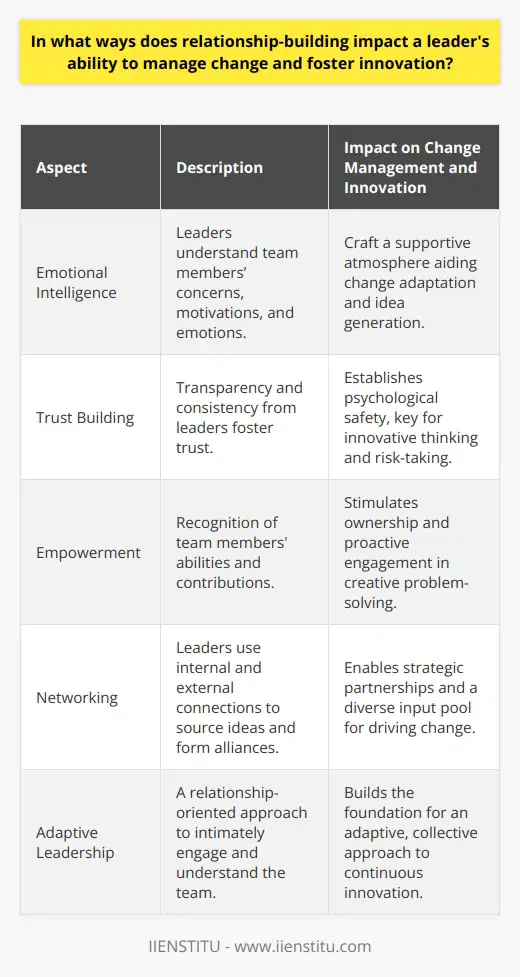
How can a leader build relationships with employees in order to foster a positive work environment?
Effective Communication
One of the essential ways a leader can build relationships with employees and foster a positive work environment is through effective communication. Regularly sharing information, giving feedback, and clarifying expectations can reduce confusion and create a culture of trust.
Emotional Intelligence
A successful leader should exhibit emotional intelligence which encompasses self-awareness, self-regulation, empathy, and social skills. By understanding and managing one's own emotions, leaders are better equipped to recognize and respond to the emotions of employees, improving team morale and productivity.
Active Listening
Demonstrating active listening is another crucial aspect in building relationships with employees. Leaders should strive to fully understand employees' perspectives and concerns by asking open-ended questions and acknowledging their feelings. This approach makes employees feel valued and respected.
Inclusivity and Diversity
Promoting inclusivity and diversity within the workplace is essential for fostering a positive work environment. Leaders should ensure that all employees feel free to express their opinions and ideas, regardless of their background or position. Appreciating and celebrating diversity can enhance innovation, collaboration, and employee satisfaction.
Providing Autonomy and Support
Encouraging employees to take ownership of their tasks while providing guidance and support can lead to a more positive workplace atmosphere. Leaders who delegate authority and trust their team's capabilities can create a sense of empowerment, resulting in increased motivation and satisfaction among employees.
Acknowledging and Rewarding Efforts
Recognizing employee achievements and rewarding their efforts is another effective way to build healthy relationships and a happy work environment. Leaders who celebrate successes and express gratitude for hard work can boost morale and inspire employees to strive for excellence.
Continuous Learning and Development
Encouraging continuous learning, growth, and development for employees can lead to a more fulfilling and positive work experience. Leaders can accomplish this by providing opportunities for professional development, discussing career aspirations, and offering constructive feedback for improvement.
In conclusion, a leader can foster a positive work environment by building strong relationships with employees through effective communication, leading with emotional intelligence, actively listening to employees, promoting an inclusive and diverse workplace, providing autonomy and support, acknowledging achievements, and encouraging growth and development. These practices can enhance employee satisfaction, motivation, and overall organizational success.
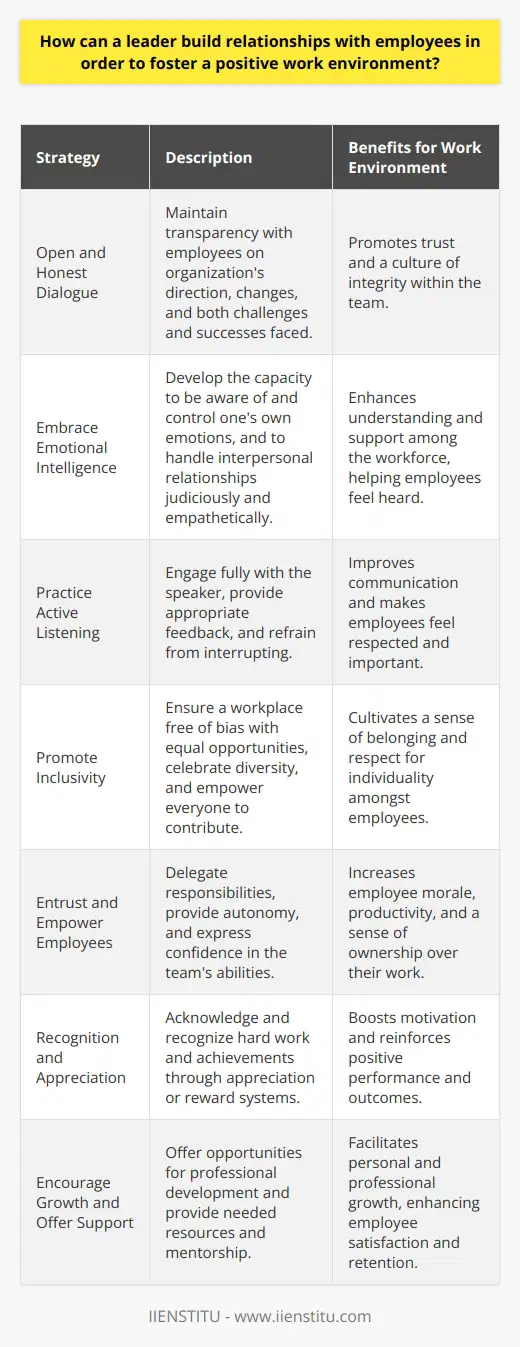
Why is it important for a leader to have meaningful relationships with their team members for overall success?
Establishing Trust and Loyalty
Meaningful relationships between a leader and their team members are vital for overall success, largely due to their ability to foster trust and loyalty. When leaders take the time to truly connect with their team, they can better understand their needs, aspirations, and concerns. By doing so, they demonstrate genuine care for their team members' well-being, which ultimately leads to the development of trust and loyalty.
Promoting Effective Communication
Moreover, establishing meaningful relationships with team members facilitates effective communication. Leaders who maintain open and honest communication with their team can identify potential issues early on, address concerns, and promote an environment where their team members feel comfortable sharing feedback. This exchange of ideas and knowledge is crucial for a team's continuous improvement and success.
Increasing Job Satisfaction and Retention
In addition, nurturing meaningful relationships within a team has a positive impact on job satisfaction and employee retention. Employees who feel valued, supported, and connected to their leaders are more likely to be satisfied with their jobs and less likely to leave the organization. This continuity within the team is important for maintaining productivity and maintaining a positive work environment.
Enhancing Leadership Skills
Partaking in meaningful relationships also enables leaders to expand their own leadership skills. Through these relationships, leaders become more in tune with their team members' needs and strengths, enabling them to provide tailored guidance and support. This customized approach ultimately helps the team members thrive and achieve their full potential, contributing to the success of the team as a whole.
Driving Organizational Success
Finally, leaders who forge meaningful relationships with their team members are better equipped to drive organizational success. As trust, loyalty, and effective communication are promoted within the team, productivity increases, and the team is better able to meet or exceed objectives. In turn, this leads to the overall success of the organization, as motivated and dedicated teams directly impact a company's growth and reputation.
In conclusion, the establishment of meaningful relationships between leaders and their team members is essential for overall success, as it fosters trust, loyalty, effective communication, job satisfaction, retention, and the development of enhanced leadership skills. Furthermore, these factors ultimately contribute to increased productivity and organizational achievement, making such relationships indispensable for leaders who are committed to achieving both personal and professional success.
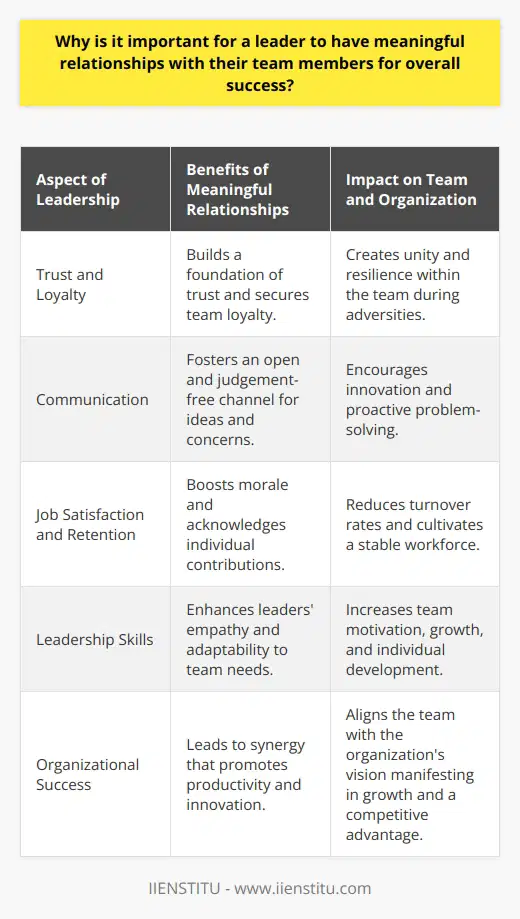
In what ways can relationship-building among leaders and their employees contribute to organizational growth and innovation?
Enhanced Collaboration
One of the key ways that relationship-building contributes to organizational growth and innovation is by improving collaboration among employees and leaders. When leaders establish and maintain strong connections with their team members, it fosters an environment of trust and open communication. Employees feel more comfortable discussing ideas and sharing their opinions, leading to a free-flow of input from various perspectives.
Increased Employee Engagement
Organizations that prioritize cultivating relationships between leaders and employees often experience higher levels of employee engagement. Engaged employees are more likely to go the extra mile and take ownership of their work. They are also more likely to stay with the organization, reducing turnover and its associated costs. Engaged employees invest their energy and passion in their work, which can be a significant driving force behind organizational growth and innovation.
Empowered Decision-Making
In organizations with strong leader-employee relationships, employees are more likely to feel empowered in their decision-making. When leaders trust their employees and provide them with the necessary tools, employees feel confident to take calculated risks and explore creative solutions. This culture of empowerment fosters innovation, as employees are more willing to engage with new concepts and ideas, leading to progress and expansion.
Improved Problem Solving
Effective communication between leaders and employees allows for better problem identification and resolution. Building relationships creates an environment where employees feel encouraged to openly discuss any potential issues or barriers. Moreover, employees are more likely to collaborate with their colleagues and leaders to develop constructive solutions. This fosters innovation, as the combined knowledge and experience of the team can lead to efficient problem-solving and the discovery of new ideas.
Knowledge Sharing and Skill Development
Strong relationships between leaders and employees encourage the sharing of knowledge and skills across the team. When employees feel supported and valued, they are more likely to seek ongoing professional development and growth. This continuous learning culture contributes to the organization's overall advancement and innovation capacity, as the combined expertise of individuals drives collective progress. Additionally, employees with varied skills and experiences can bring fresh perspectives, enriching the innovation process.
In conclusion, relationship-building among leaders and their employees plays a crucial role in fostering organizational growth and innovation. By cultivating an atmosphere of trust and collaboration, promoting employee engagement and empowerment, and facilitating knowledge sharing and skill development, organizations can unlock the potential for progress and expand their capacity for creative and innovative solutions.
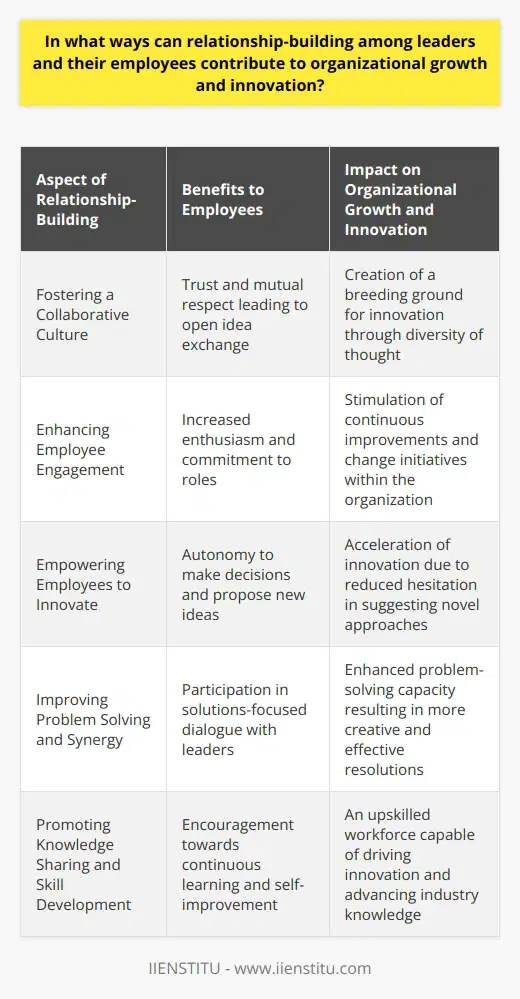
How can leaders establish trust and credibility as a foundation for building strong relationships with their team members?
Establishing Trust and Credibility
One crucial aspect of effective leadership is the ability to establish trust and credibility within the team. Leaders can accomplish this through consistent communication, demonstrating competence, and fostering a collaborative environment. These key strategies create a solid foundation for building strong relationships with team members.
Consistent Communication
Effective communication plays a significant role in developing trust and credibility among team members. By sharing information transparently, providing constructive feedback, and listening actively, leaders can create an open and inclusive atmosphere. This approach encourages team members to share their concerns openly, fostering trust and respect within the team dynamics.
Demonstrating Competence
An essential aspect of instilling trust and credibility is demonstrating competency in specific areas aligned with the team's objectives. When leaders display expertise in their field, team members feel assured that their leader is capable of guiding and supporting the team's growth. Additionally, cultivating professional development opportunities for team members demonstrates the leader’s investment in their success, reinforcing credibility.
Fostering Collaboration
Encouraging a collaborative environment within the team further establishes trust and credibility. When leaders involve team members in decision-making processes, valuing their input and expertise, they demonstrate their respect and trust in their abilities. Empowering individuals to take on responsibilities and contribute to the team’s goals solidifies the leader’s investment in each team member’s capabilities, thereby strengthening their trust and credibility within the group.
In conclusion, leaders can establish trust and credibility as a foundation for building strong relationships with their team members by consistently communicating, demonstrating competence, and fostering a collaborative environment. These strategies not only create an atmosphere conducive to trust and credibility but also contribute to the overall success of the team.
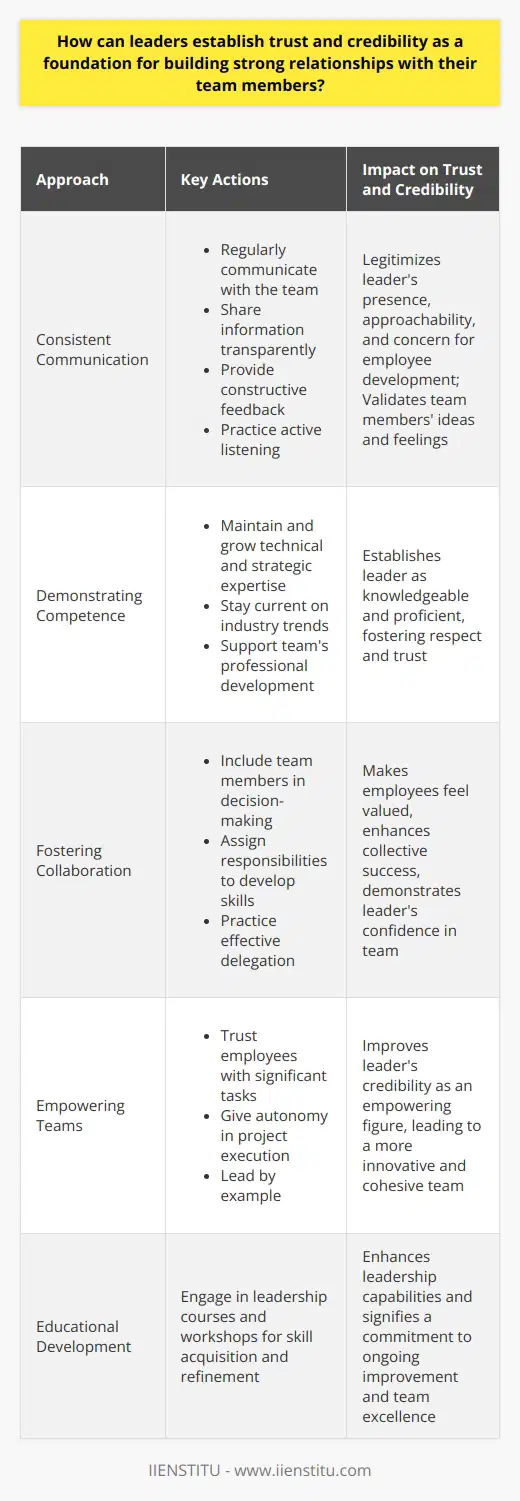
What role does communication play in fostering effective relationships between leaders and employees, and how can leaders ensure they are communicating effectively?
Role of Communication in Leadership
Effective communication is vital in fostering successful relationships between leaders and employees. It facilitates the creation of trust, collaboration, and a shared understanding of the organization's goals and objectives. Without efficient communication, misunderstanding and misinterpretation are more likely to occur, leading to a negative impact on the overall productivity and morale of the team.
Open Channels for Two-way Communication
Leaders should prioritize establishing open channels of communication, encouraging employees to express their ideas, opinions, and concerns. By actively seeking feedback and practicing active listening, leaders demonstrate their commitment to understanding employees' perspectives and collaborating to reach mutual goals. This open dialogue fosters trust and appreciation, strengthening the relationship between leaders and employees.
Clarity in Messages and Expectations
A crucial aspect of effective communication is ensuring clarity in the messages conveyed. Leaders should strive to articulate their expectations, goals, and objectives clearly to minimize the risk of misinterpretation. Providing specific guidance, setting realistic targets, and offering explicit instructions are essential in setting up employees for success and maintaining a healthy working relationship.
Leveraging Different Modes of Communication
Leaders should adopt a versatile communication approach to cater to the diverse needs of employees. Different people have different learning styles and preferences, so utilizing various modes of communication, such as verbal and non-verbal cues, meetings, written memos, and digital communication platforms, can enhance overall effectiveness. This flexibility ensures that all employees feel heard and their opinions are valued, further strengthening the bond between leadership and staff.
Regular Feedback and Performance Reviews
Implementing regular feedback and performance reviews serves as an essential tool in communication-driven leadership. Constructive and timely feedback allows employees to identify areas for improvement, while positive feedback acts as a powerful motivator. Regularly evaluating performance helps both leaders and employees stay aligned on expectations and progress towards desired outcomes.
In conclusion, for leaders to nurture effective relationships with employees, they should prioritize clear and open communication, utilizing a versatile approach that caters to individuals' preferences and includes regular feedback mechanisms. This commitment to effective communication fosters trust, collaboration, and shared understanding, enhancing overall team performance and satisfaction.
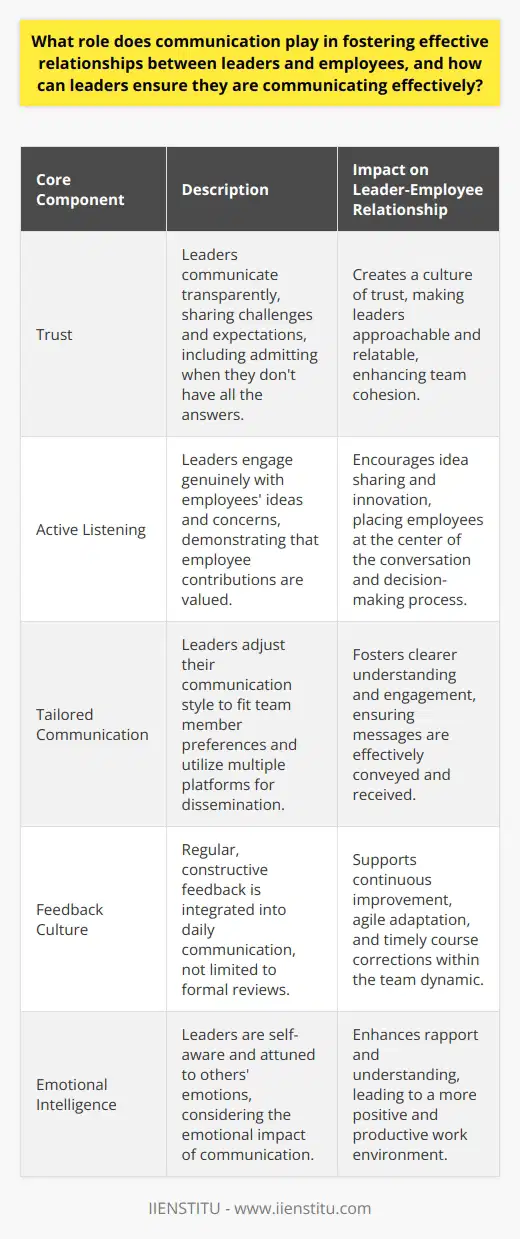
Why are building relationships important for success within a leadership role?
The Significance of Building Relationships for Leaders
Establishing Trust and Rapport
One key reason building relationships is essential in a leadership role is it fosters trust and rapport between the leader and their team. When leaders invest in building strong connections, they gain their team's confidence and create a sense of alliance, which is crucial for success. Moreover, solid relationships allow for open communication and willingness to work together towards common goals.
Enhancing Team Performance
Another benefit of building relationships is the positive impact on overall team performance. The team members are more likely to be motivated and engaged in the projects when they have a strong bond with their leader. Furthermore, cultivating interpersonal relationships contributes to team cohesion, improving collaboration and the sharing of innovative ideas. This group synergy directly impacts the team's productivity and achievement of objectives.
Promoting a Positive Work Environment
Relationship-building also plays a crucial role in promoting a healthy and positive work environment. As leaders foster a culture of inclusivity and respect, it enhances the team's morale and job satisfaction. When employees feel valued and connected, they are less likely to experience burnout and turnover, leading to higher retention rates and more stable teams.
Facilitating Conflict Resolution
Strong relationships within a leadership role are invaluable when it comes to addressing conflicts and finding solutions effectively. When individuals trust their leader and feel comfortable sharing their opinions, conflicts are more likely to be handled constructively. By having established relationships, a leader can resolve disputes by understanding the diverse perspectives and finding a common ground that respects everyone's opinion.
Increasing Influence and Impact
Lastly, successful relationship-building contributes to the leader's influence and impact within the organization, beyond their immediate team. As leaders establish connections with peers, subordinates, and superiors, they gain access to wider networks and resources that can support their agendas. Nurturing these relationships can make it easier for a leader to navigate the organization's complexities and drive change more effectively.
In conclusion, building relationships is a critical element for achieving success in leadership roles. By strengthening interpersonal connections, leaders can foster trust, enhance team performance, create a positive work environment, manage conflict, and increase their overall influence. As such, relationship-building should be regarded as an indispensable skill for any effective leader.
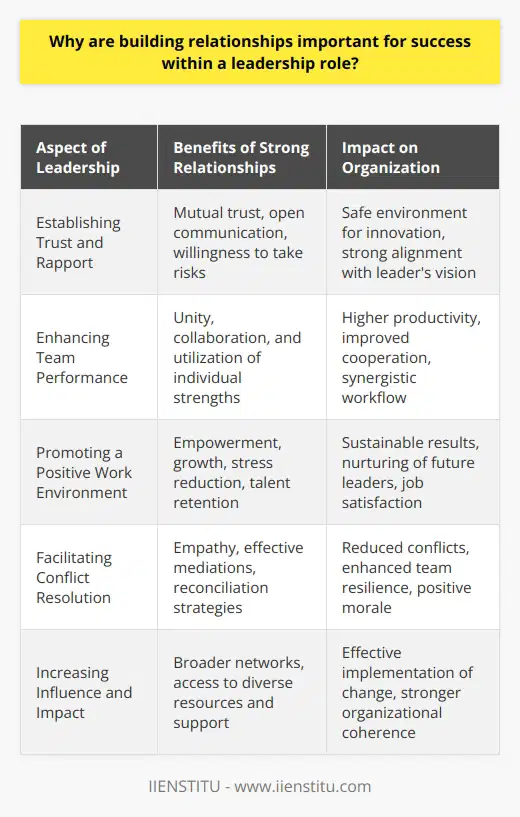
What key elements contribute to the development of strong professional relationship building skills for leaders?
Understanding the Skills for Relationship Building
To develop strong professional relationship building skills, leaders must prioritize empathy, active listening, emotional intelligence, open communication, and accountability. By fostering these key elements, leaders can create a sense of trust and mutual respect, which are essential for successful professional relationships.
Emphasizing Empathy
Empathy enables leaders to understand the perspectives, needs, and emotions of others. Possessing empathetic skills allows leaders to respond to challenges and solve problems more effectively, as they take into consideration the perceptions and emotions of their team members.
Active Listening
Active listening is the process of fully attending to, comprehending, and responding to what others are communicating. Through active listening, leaders demonstrate their respect for others, making those involved feel valued and understood. This skill helps build strong relationships by promoting open and honest conversations.
Emotional Intelligence
Emotional intelligence refers to the ability to recognize, understand, and manage one's own emotions and the emotions of others. Leaders with high emotional intelligence can navigate difficult situations and adapt their behavior to achieve a positive outcome, which in turn contributes to strong professional relationships.
Promoting Open Communication
Encouraging open communication in a professional setting fosters trust and respect among team members and builds a healthy working environment. By creating an atmosphere where everyone feels comfortable sharing their thoughts and ideas, leaders can nurture relationships and drive better results.
Accountability and Trust
Accountability is the willingness to take responsibility for one's actions and decisions. Leaders who exhibit accountability establish trust by being transparent and holding themselves accountable for the outcomes of their actions. This sense of trust further strengthens professional relationships, as team members feel confident in their leader's ability to guide them towards success.
In conclusion, the development of strong professional relationship building skills for leaders hinges on the incorporation of empathy, active listening, emotional intelligence, open communication, and accountability. By prioritizing these elements, leaders can forge long-lasting and meaningful relationships, ultimately contributing to the success of their team and organization.
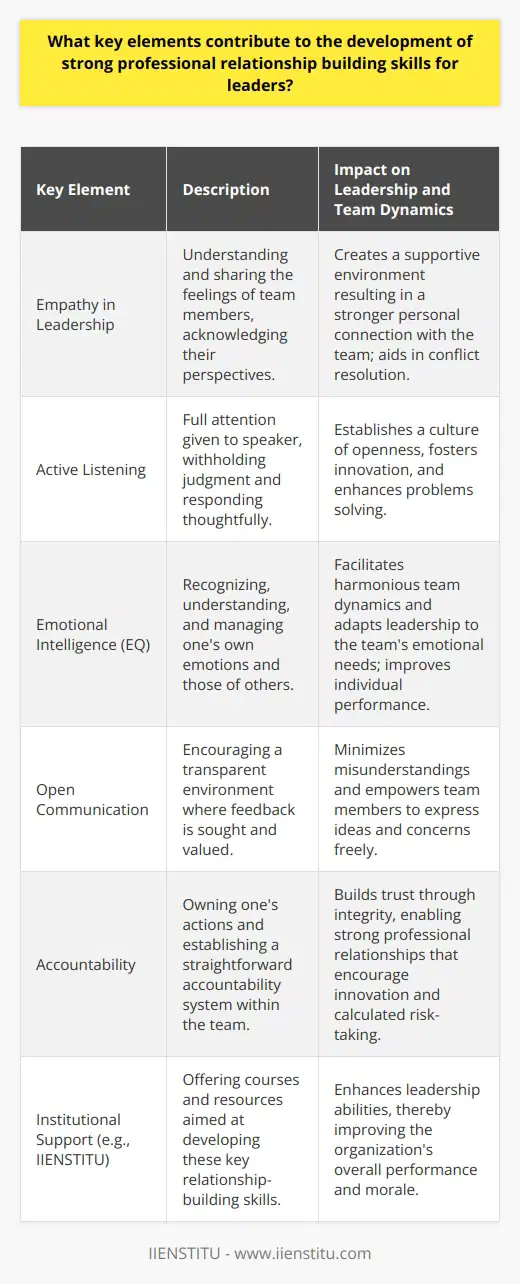
In which ways do leaders rely on collaborative relationships to achieve organizational goals and objectives?
Collaborative Relationships: A Key to Organizational Success
Leaders depend on collaborative relationships to attain organizational objectives in multiple ways, including building trust, enhancing communication, fostering innovation, and ensuring the sharing of resources and expertise. By establishing trust, leaders create a working environment wherein team members feel secure, confident, and appreciated. Trust is crucial in facilitating transparent and open communication among team members, ultimately leading to improved decision-making, problem-solving, and information flow.
Enhancing Communication
Effective communication is an essential component in realizing shared organizational goals. Through collaboration, leaders can promote open dialogue and active listening, which in turn encourages a positive feedback culture and drives consensus among team members. In such a communicative environment, individuals can voice their opinions, concerns, and insights, ensuring that the best ideas are put into action. In addition, this open communication leads to a supportive and inclusive atmosphere, increasing employee motivation and commitment to the organization's objectives.
Fostering Innovation
Collaborative relationships also facilitate innovation within an organization. Leaders who encourage teamwork and cooperation create a breeding ground for creativity, as employees from diverse backgrounds come together to share their ideas, skills, and experience. This diversity of perspectives and expertise drives the development of new products, services, and strategies, enabling organizations to stay competitive and meet the evolving needs of their customers. Moreover, collaborative problem-solving helps to identify opportunities for improvement, ultimately enhancing the organization's overall performance.
Sharing Resources and Expertise
Ultimately, achieving organizational goals requires the efficient use of available resources and the pooling of collective expertise. As collaboration fosters cross-functional partnerships, employees can seamlessly share their skills and knowledge, thereby guiding one another toward success. Leaders can capitalize on this resource-sharing by allocating tasks based on individual strengths, avoiding duplication of efforts, and leveraging economies of scale. Furthermore, these collaborative relationships can extend beyond the organization's boundaries, enabling leaders to tap into external networks, uncover new opportunities, and negotiate better deals with suppliers and partners.
In conclusion, leaders who prioritize collaborative relationships engender a culture of trust, open communication, innovation, and resource sharing – all of which are crucial for achieving organizational goals and objectives. By cultivating these important connections, leaders can enable their organizations to thrive in an increasingly competitive and ever-changing business landscape.
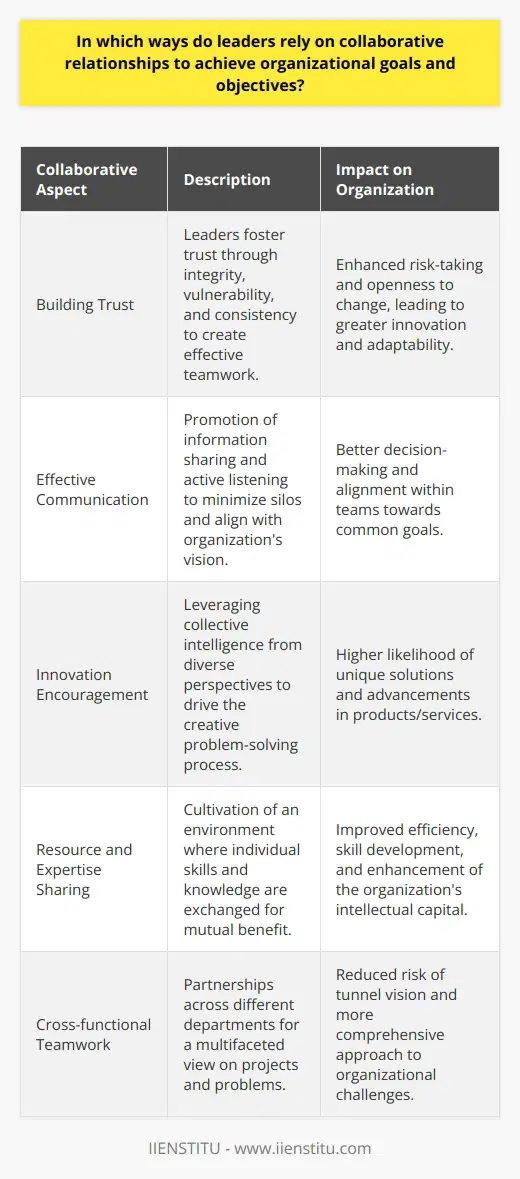
How can leaders build relationships with employees to foster collaboration and enhance team performance?
Establishing Trust and Open Communication
To cultivate collaboration and enhance team performance, leaders must first establish trust and open communication with employees. By approaching team members with sincerity, empathy, and honesty, leaders can foster strong connections that make employees feel valued and supported. Trust is the foundation of effective collaboration, and it is crucial for leaders to demonstrate their own reliability and dependability to build this fundamental element within their team.
Encouraging Employee Growth
Additionally, leaders can strengthen relationships with employees by promoting their professional growth and development. This includes offering regular feedback, recognising accomplishments, and providing opportunities for skill-building or learning advancement. By investing in the success of each team member, leaders demonstrate that they care about the long-term well-being and progress of their employees. This recognition and support naturally inspire employees to contribute their best efforts to the team, driving collaborative success and overall performance.
Creating a Shared Vision
Leaders should also focus on creating a shared vision and aligning individual goals with the broader objectives of the organization. By involving employees in the decision-making process and encouraging their active participation in shaping the team's goals, leaders demonstrate that they value and respect the contributions of each individual. This sense of unity and shared purpose fosters collaboration by motivating employees to work together towards achieving both personal and collective targets.
Regular Team Building Activities
Lastly, incorporating regular team-building activities can help leaders to nurture relationships with employees. Well-designed exercises facilitate communication, promote problem-solving, and encourage bonding among team members. These activities allow employees to develop mutual trust and understanding while also improving their social and emotional dynamics in the workplace. Consequently, a harmonious team environment emerges, leading to greater collaboration and heightened team performance.
In conclusion, leaders can foster collaboration and enhance team performance by establishing trust and open communication, encouraging employee growth, creating a shared vision and engaging in regular team-building activities. By implementing these strategies, leaders enable employees to thrive both professionally and personally, fostering a well-integrated, efficient, and harmonious team dynamic.
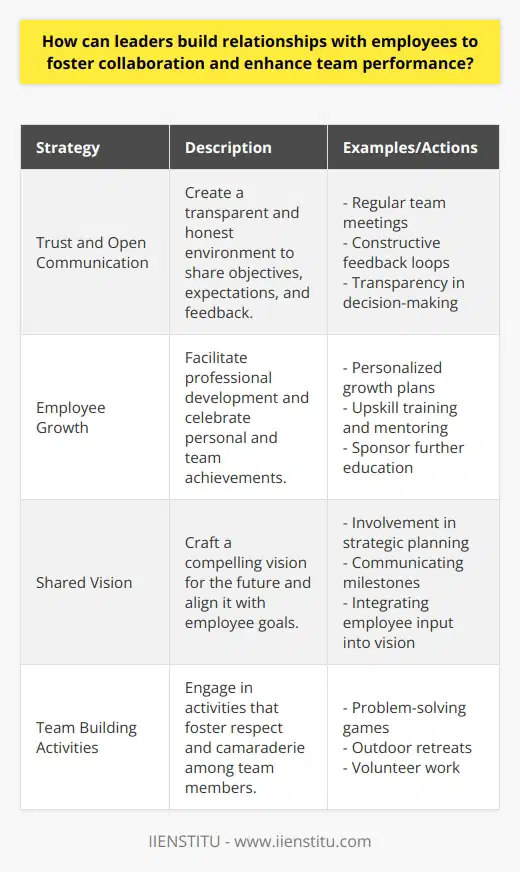
Why are interpersonal connections essential for shaping a leader's ability to guide their team through challenges and change?
The Power of Interpersonal Connections
Interpersonal connections play a critical role in shaping a leader's ability to guide their team through challenges and change. Building and maintaining strong relationships with team members enables leaders to better understand their individual strengths, weaknesses, and motivations. This deeper understanding helps leaders identify their team's unique capabilities and align them with the organization's goals and objectives.
Effective Communication Skills
Effective communication is a cornerstone of strong interpersonal connections. A leader's ability to communicate their vision, expectations, and feedback is essential to establishing trust, encouraging open dialogue, and promoting ongoing collaboration. This fosters an environment of continuous learning and growth, which is crucial in navigating through challenges and change.
Empathy and Emotional Intelligence
Emotional intelligence is the ability to recognize, understand, and manage one's own emotions and those of others. It is a vital component of mastering interpersonal connections. When leaders demonstrate empathy, they create an atmosphere of support and understanding. By being sensitive to their team's emotional needs, leaders can better manage stress levels and inspire resilience in the face of adversity. This emotional support fosters loyalty and commitment, allowing the team to adapt to new situations with greater ease and efficiency.
Influence and Collaboration
Interpersonal connections are essential for effectively leveraging a leader's influence. By cultivating strong relationships with their team, leaders can encourage collaboration, which leads to the development of innovative solutions to challenges. Collaborative efforts strengthen team cohesion, enabling them to tackle complex tasks and navigate change smoothly. Furthermore, a leader's influence can help rally team members around a shared mission and values, boosting morale and driving exceptional performance.
In conclusion, interpersonal connections are instrumental in shaping a leader's ability to guide their team through challenges and change. By strengthening relationships with team members, leaders can foster open communication, tap into their team's emotional intelligence, and harness the power of influence and collaboration. As a result, leaders are better equipped to navigate the complexities and uncertainties of today's fast-paced and dynamic business landscape.
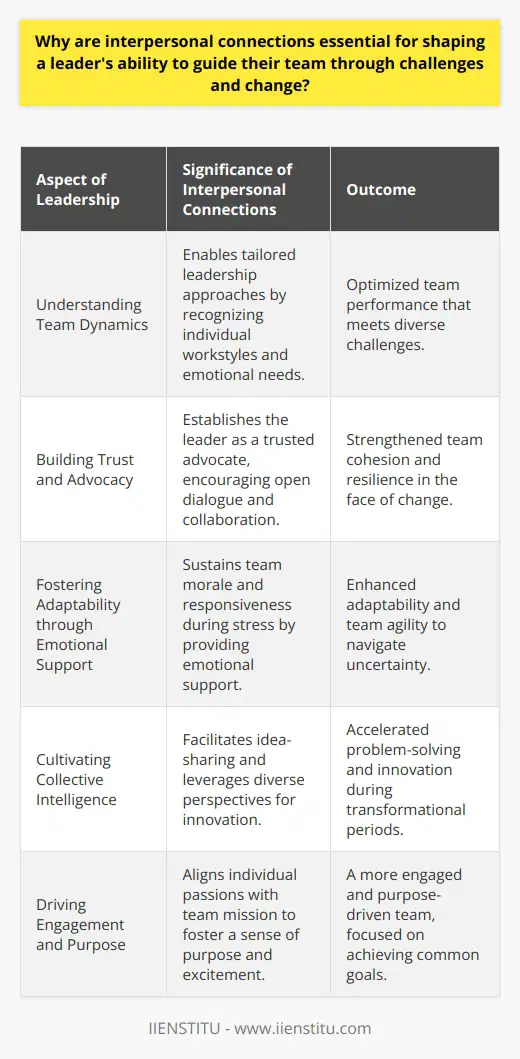
In what ways can effective communication and active listening improve the overall quality of work relationships between leaders and their employees?
**Effective Communication Enhances Collaboration**
Effective communication is crucial in ensuring that leaders and their employees work together harmoniously towards achieving common goals. By clearly expressing expectations, goals, and performance feedback, leaders establish an environment that promotes trust and respect. Also, employees feel motivated and heard, which boosts their morale and results in higher productivity.
**Active Listening Fosters Understanding**
Active listening plays an integral role in improving work relationships as it allows leaders to genuinely understand the views and concerns of employees. By engaging in active listening, a leader demonstrates empathy and an open mind, fostering a positive work environment. This leads to employees feeling valued, leading to increased job satisfaction and commitment to the organization.
**Feedback Exchange Improves Performance**
Transparent and regular feedback exchange between leaders and employees is another essential aspect of effective communication. These constructive feedback sessions minimize misunderstandings and enhance employees' understanding of their roles and performance expectations. Consequently, employees feel motivated to improve and strive for excellence, resulting in higher overall performance.
**Conflict Resolution Promotes Harmony**
In a work setting, conflicts are inevitable; however, effective communication and active listening can help in reducing misunderstandings and resolving conflicts in a timely manner. A leader who communicates effectively and listens actively can address differences in opinions and guide their team members to work together more efficiently. This promotes a harmonious work environment that is conducive to employees' growth and development.
In conclusion, effective communication and active listening foster collaboration, understanding, performance improvement, and conflict resolution in work relationships. By implementing these essential skills, leaders can establish strong connections with their employees, leading to a more productive and healthy work environment.
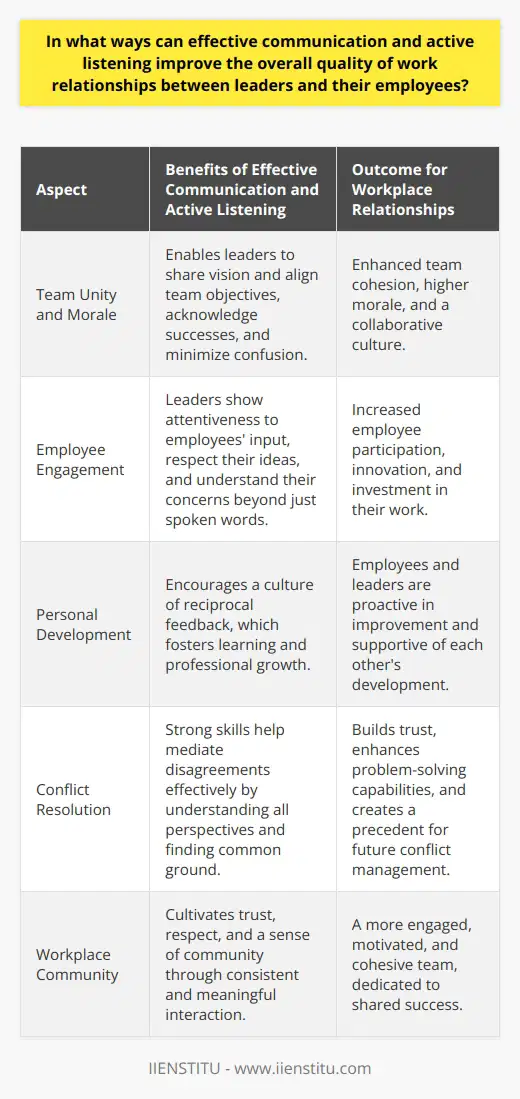
How can leaders leverage the power of relationship-building to enhance their problem-solving and decision-making capabilities?
Empowering Decision Making through Relationship Building
Leaders can significantly enhance their problem-solving and decision-making capabilities by building strong relationships. Having strong ties with team members fosters trust, encourages open communication, and allows for diverse perspectives in decision making.
Trust and Open Communication
Trust is fundamental among team members. A leader who has built trust within the team increases the likelihood of open communication. Team members feel comfortable sharing their views, suggestions, and potential solutions to problems without fear. Consequently, this improves the quality of decisions made by the leader.
Considering Diverse Opinions
In teams where leaders have cultivated strong relationships, there is diversity in thought. Having a varied perspective enriches discussions on how to solve problems. It provides the leader with multiple viewpoints to analyze, thus enhancing their ability to make informed decisions.
Influence of Emotional Intelligence
A leader’s emotional Intelligence directly affects their ability to build relationships. Leaders who effectively manage their emotions and empathize with their team cultivate an atmosphere of mutual respect. This ambiance encourages team participation in problem-solving and decision making.
The Role of Feedback
Strong relationships enable leaders to provide and receive feedback effectively. Feedback from team members provides an external perspective on a leader’s approach to decision making and problem-solving. This perspective may highlight potential areas of improvement in the leader’s approach.
In summary, leaders who leverage the power of relationship building cultivate trust, encourage open communication, avail diverse perspectives, utilize emotional intelligence, and create feedback channels. These factors together significantly enhance their problem-solving and decision-making capabilities.
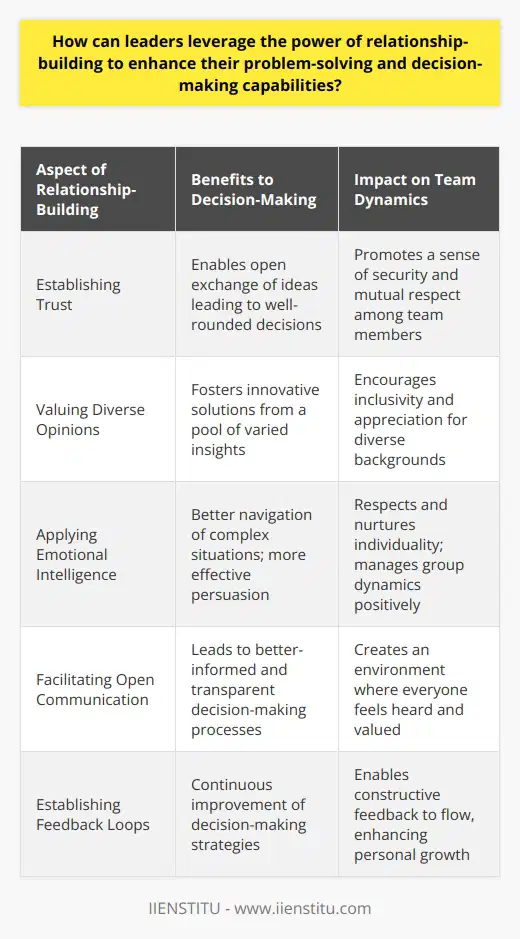
What role does empathy play in the process of cultivating meaningful relationships for leaders, and how can leaders develop their empathetic skills to better connect with their team members?
Role of Empathy in Leadership
Empathy plays a crucial role in fostering meaningful relationships for leaders. It forms the backbone of effective communication and understanding. Empathy enables leaders to relate with team members' perspectives, experiences, emotions and challenges. By understanding and appreciating these aspects, leaders forge deeper connections, fostering mutual respect and trust.
Enhancing Leaders’ Empathetic Skills
Leaders can enhance their empathetic skills through various methods. Active listening involves paying attention, resisting interruptions and seeking clarification. This demonstrates respect for team members’ viewpoints, promoting an environment of openness and transparency.
Practicing Mindfulness and Self-awareness
Another essential practice is cultivating mindfulness and self-awareness. Being aware of one's emotions and reactions can prevent negative responses, providing opportunities to show empathy instead. Attending workshops or engaging in team activities can also contribute to developing these skills.
Understanding Team Members
Moreover, leaders should know their teams. Understanding individual strengths, weaknesses, aspirations and motivations can enhance empathetic connections. Plus, when leaders show genuine interest in team members’ personal and professional lives, it promotes a sense of belonging and loyalty.
Empathy in Decision-making
Lastly, empathy should feature in decision-making processes. Leaders should consider the impact of their decisions on team members. Such consideration shows that leaders value their team, further enhancing the relationship.
In conclusion, empathy facilitates closeness, unity and productive cooperation within a team. By continually striving to enhance empathetic skills, leaders can foster meaningful relationships, thereby building more effective and cohesive teams.
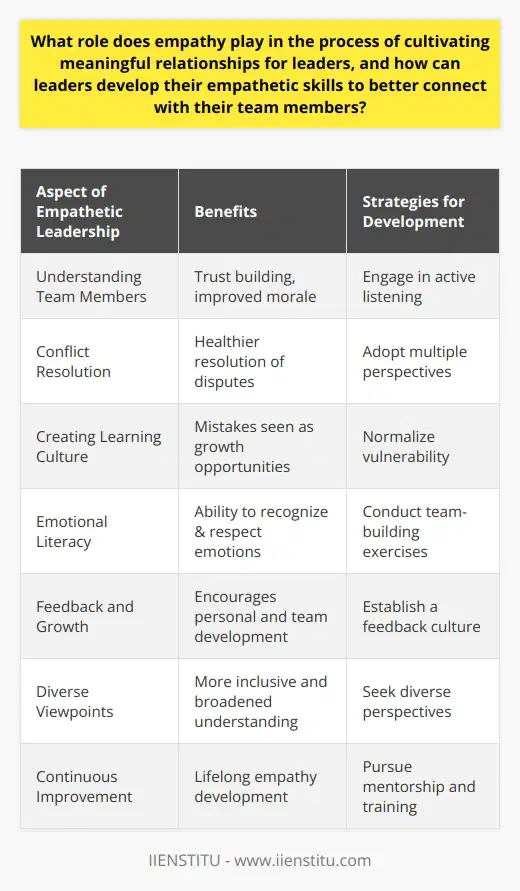
How can a focus on relationship-building contribute to a leader's ability to foster a supportive and inclusive organizational culture that embraces diversity and innovation?
Relationship-Building and Organizational Culture
A leader's focus on relationship-building significantly contributes to creating an inclusive and supportive organizational culture.
Importance of Relationships in Leadership
Leaders who prioritize relationship-building often foster trust, empathy, and collaboration in their teams. These elements are critical for inclusion and support in a workforce. By valuing every employee's input, leaders can tap into diverse perspectives and unique problem-solving approaches.
Impact on Diversity
Diversity requires an atmosphere of inclusion, comfort, and respect. This environment materializes when leaders build strong relationships with employees, highlighting each individual's unique contributions. These relationships allow leaders to appreciate, recognize, and nurture diversity in their teams, which stimulates a sense of belonging and inclusivity.
Promotion of Innovation
Furthermore, strong relationships encourage open communication and the free expression of ideas. In such an environment, innovation thrives. Leaders who establish and maintain strong interpersonal relationships with their teams provide the appropriate atmosphere for brainstorming, creative thinking, and experimentation.
Role of Trust
Trust plays a vital role in supporting diversity and innovation. Leaders foster trust by building and maintaining relationships. Trust encourages employees to think out of the box and take calculated risks, enhancing creativity and innovation.
In conclusion, relationship-building enhances a leader's ability to nurture a supportive and inclusive culture. It promotes diversity and drives innovation, making it a critical leadership skill.
